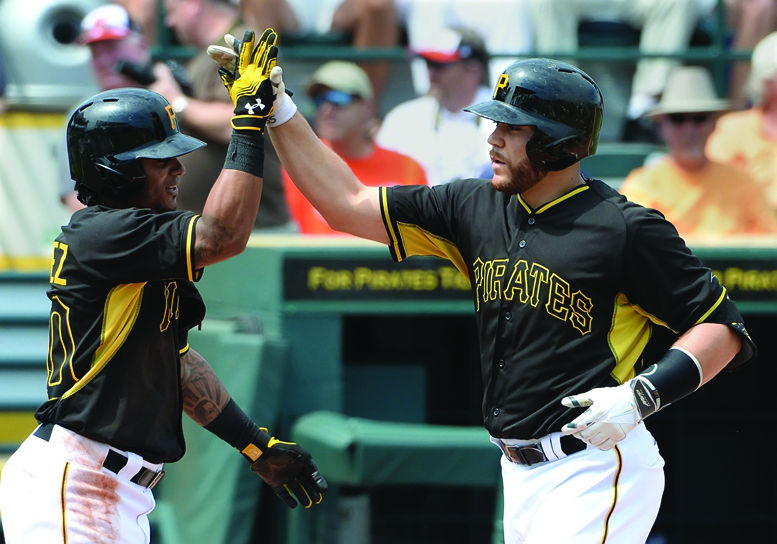Russell Martin should be the offseason priority
September 23, 2014
Do you hear that sound? No, that’s not the screaming fans in a sold-out PNC Park. That’s the cha-ching of a cash register after every clutch hit by Russell Martin.
Two years ago, the Pirates signed the catcher to a two-year, $17 million deal. Coming off a .211 average and .714 OPS year with the Yankees, it seemed like an overpay. For a team with limited revenue, signing Martin seemed like a desperate move to fill a weak spot. There were better ways for the Pirates to spend their money.
Martin was once one of the best catchers in baseball, combining a .293 average and .843 OPS with tremendous defense when he played with the Dodgers in 2007, which was his second year in the league. But in the succeeding years, Martin’s abilities began to decline. His offense and defense regressed every year. By the time the Pirates signed him, he seemed like an average to barely-above-average catcher.
I couldn’t have been more wrong.
The only thing more surprising than Martin’s transformation was that of the whole team, which became a legitimate playoff contender. The once-dwindling player is now a smooth-hitting, rocket-armed, brick-wall-dynamo of a player. And not even that does him justice. It’s safe to say he may be the best catcher in the MLB.
Last season, his hitting did not improve much from his Dodgers days, as he posted only a .226 average and .704 OPS. His defense, on the other hand, was sensational, throwing out 36 of 53 runners an astonishing .404 percent of the time. The 36 runners thrown out was good for first in the MLB, and the percentage was third.
Then, add in Martin’s ability to keep nearly every ball in front of him. No perfect statistic can quantify it, but as someone who watches nearly every Pirates game, I can assert that Martin is a brick wall back there. No matter how badly the pitcher misses, or how far off the plate the ball lands, Martin keeps it in front of him. His .998 fielding percentage, first among his position last year, speaks to that, along with his overall steadiness and consistency behind the plate.
On top of that, consider his expert ability in calling games. Martin has an undeniable chemistry with his pitchers, is seemingly never waved off and always calls for the right pitch in the right situation.
“He’s, in my opinion, one of the best in the game,” Tony Watson, a relief pitcher on the team told Pirates Prospects on Sept. 11. “What he does for us, in calling games, reading hitters, scouting reports and things like that, is second to none.”
Martin produced a 4.3 WAR (wins above replacement) in 2013, good for fifth among catchers.
This season, Martin has continued his defensive prowess while exponentially improving his offense. Behind the plate, Martin has thrown out 35 of 55 runners, which makes him first in the MLB again. His pitch calling and ball stopping abilities are still elite as well — skills I’ve really begun to appreciate any time he does not start.
When the Pirates play Chris Stewart, a catcher with a good defensive reputation in his own right, the defense takes a significant drop. I would constantly say to myself, “Martin would have stopped that,” or, “Martin would’ve thrown him out.”
On the other side of the ball, Martin has been sensational, hitting .297 with a .408 on-base percentage and .850 OPS. The latter two numbers would rank first among his position if he had enough at-bats to qualify.
Then there’s the clutch hitting. Just this weekend, Martin had the game winning RBIs in two games against the Brewers. On the year, Martin bats .383 with a 1.032 OPS with runners in scoring position, a dramatic improvement over last year when he hit .192 with a .572 OPS in that situation.
The change has been astonishing. Once a pull-heavy, big swinger with the Yankees, Martin has become incredibly patient, waiting for his pitch and then driving it.
“You look at his numbers from last year, his first checkmark on what he needed to improve on was hitting with runners in scoring position,” Pirates manager Clint Hurdle said. “It’s all about his approach, his stubbornness in the plate, giving up big swings and trying to make hard contact with the pitches hit.”
All of this has combined to produce a 5.3 WAR, second among catchers only to Jonathan Lucroy’s 6.5. Martin has 200 less at-bats than Lucroy, so it’s fair to assume that given equal time, Martin would surpass him. Next to Andrew McCutchen, he may be the most irreplaceable player on the Pirates.
What’s all of this worth? Well, in 2012, Yadier Molina, often thought as the paragon of catchers, signed a five-year, $75 million contract extension. Molina was 29 years old at the time, while Martin is 31 now. Catchers decline rapidly with age, though Martin hasn’t shown any sign of that yet. Considering he’ll be on the open market after this season — while Molina wasn’t — it’s safe to predict that Martin will get $15-$20 million a year from somebody.
Whether that money will come from the Pirates remains to be seen. It likely won’t. In the meantime, Martin should be appreciated for what he’s done.
Without him, the Pirates probably would not make the playoffs last year or this year. With him, though, they’re a World Series contender.








